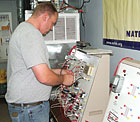
Deal Albright participates in the Build a Tech Class.
Everyone can stand to learn something new, and the advent of electronic teleconferencing, Internet-based lecture series, and online e-learning have made that kind of educational option more affordable than it has ever been.
Michael Moore, director of training and development for Lennox Industries, said the company takes training seriously with several different regimens over the years. It’s not just education for techs either; the company puts a premium on getting all of their people new skills.
“We do training on our products, sales, technology and management,” he said. “We train people in business.”
He said the company tries to cover the whole spectrum of training and development for the people who work for it. And they do a lot of it. Over all of the 2009 business year, almost 27,000 “touches” (people using the courses) were made through the program which includes a fair portion of e-learning.
“With e-learning we can touch more people,” Moore said. “It used to be that our training programs were 100 percent instructor-led. Over the last five years, we’re 70 percent electronic.

Jeff Lamb has learned a lot under teacher Gene Goff.
“The economy has gotten tighter,” he said. “People have less time for training and fewer employees. E-learning is a lot more cost-effective and companies can train their people in a much more economical fashion.”
Cheaper, yes, he said, even if Lennox is spending a bit more for training since the advent of online and teleconference training. But even though the company is spending more actual money on training now, they’re reaching a far larger number of people.

Justin Trout attends a class offered by HVAC Learning Solutions.
From there, Moore and his department work to find the right kind of training for them - both in subject and in medium.
Electronic solutions for training has been a great boon to the industry, but it’s by no means the only game in town. There’s still a place for old-fashioned schoolroom learning in the 21st century. The online courses offered by the company are there to bring people to a point where they’re ready, technically and as students, to get in-depth training in a traditional setting.
“Ultimately, you want something that’s blended,” he said. “We try to use e-learning to take people through their basic training so they’re ready for traditional instructor-led programs. A classroom environment is more meaningful if the students are ready to learn.”
There are four-week and six-week courses offered by Lennox, the longer ones tend to be instructor-led.

Nick Gates works hard in the Build a Tech Class.
A DIFFERENT ANGLE
John Teder, training manager for International Comfort Products, is looking at training from a different angle. He said the company is making sure the front office has a good training regimen as well.“For many years, ICP has emphasized dealer sales and business management training,” he said. “We have worked closely with independent wholesalers to teach dealers how to build value in their businesses, attract more customers, and sell more premium-featured systems at higher profit margins.”
And that’s the kind of business Teder has been in for a long time. Since 1991, he has traveled the country leading seminars as a sales and business management instructor for ICP. While the majority of HVAC business owners are technically sound, he believes that many of them have never received adequate sales or business management training. His seminars help HVAC business owners, sales professionals, and key employees across the country increase their sales and business management skills leading to an increase in profits for the companies they represent.

The Build a Tech Class is an intensive training class held for several weeks.
“New this year, we are offering HVAC Profit Shots,” Teder said. “They’re 90-minute online training workshops designed to let distributors offer in-house dealer training via the Internet. While face-to-face training is a vital component of our training plans, online training can multiply our effectiveness by giving us a tool to train more dealers more often at a substantial cost savings.”
The Profit Shots program allows distributors to get their employees brought up to speed on the newest training concepts without having to pay for a trainer to come in personally. The sessions are designed to be quick studies so those employees can get their training without crippling the business for several hours on training day. The ICP programs include customer relations, pricing practices for best profitability, handling customer objections, and how to use service technicians as a “silent sales force.”
Publication date:05/31/2010

Report Abusive Comment